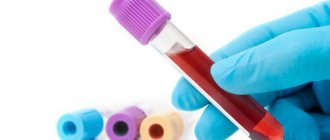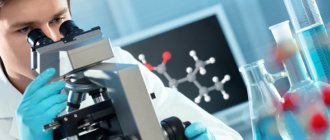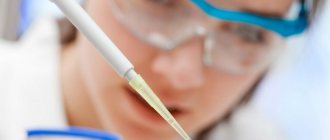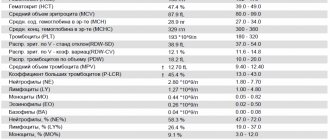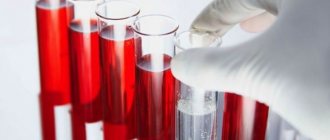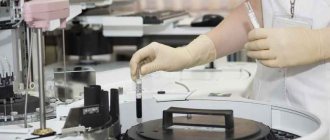In the article you will read what indicators are included in a general urine analysis, what are the reference intervals for these indicators, what is the norm of leukocytes and red blood cells in the urine, how much protein and sugar can be in the urine, what epithelial cells are found in the analysis.
The information was prepared by doctors from CIR laboratories and clinics.
A general clinical examination of urine (general urinalysis, OAM) includes the determination of physical properties, chemical composition and microscopic examination of sediment.
Urine color
The color of urine normally ranges from light yellow to deep yellow and is due to the pigments it contains (urochrome A, urochrome B, uroethrin, uroresin, etc.).
Reference values:
| Children | Various shades of yellow |
| Men | Various shades of yellow |
| Women | Various shades of yellow |
Interpretation
The intensity of the color of urine depends on the amount of urine excreted and its specific gravity. Rich yellow urine is usually concentrated, excreted in small quantities and has a high specific gravity. Very light urine is slightly concentrated, has a low specific gravity and is excreted in large quantities.
Discoloration may be the result of a pathological process in the urinary system, the effects of dietary components, or medications taken.
The norm of red blood cells in tests in adults
On blood test forms, red blood cells are designated by the Latin abbreviation RBC.
The normal number of red blood cells depends on gender and age.
- For men 18-45 years old it is 4.3 x 1012 - 5.7 x 1012 / l, and for women 18-45 years old it is 3.8 x 1012 - 5.1 x 1012 / l.
- For men 45-65 years old it is 4.2 x1012 - 5.6x1012 /l, and for women 45-65 years old it is 3.8 x1012 - 5.3x1012 /l.
- For men over 65 years old it is 3.8 x 1012 - 5.8 x 1012 / l, and for women over 65 years old it is 3.8 x 1012 - 5.2 x 1012 / l.
Young forms of red blood cells are called reticulocytes. Normally, their content in the blood should not exceed 0.2-1.2% of the total amount. An increase in the content of reticulocytes in the blood (reticulocytosis) in the treatment of anemia caused by a lack of vitamin B12 in the body is an early sign of recovery.
Transparency (turbidity)
Normal urine is clear. Cloudiness of urine can be the result of the presence of red blood cells, leukocytes, epithelium, bacteria, fat droplets, precipitation of salts, pH, mucus, urine storage temperature (low temperature promotes the precipitation of salts).
In cases where the urine is cloudy, you should find out whether it is immediately cloudy, or whether this cloudiness occurs some time after standing.
| Children | Full transparency |
| Men | Full transparency |
| Women | Full transparency |
Specific gravity of urine (g/l)
In a healthy person, it can fluctuate over a fairly wide range throughout the day, which is associated with periodic food intake and loss of fluid through sweat and exhaled air.
| Children under 1 month | 1002-1020 |
| Children 2 – 12 months | 1002-1030 |
| Children 1 year - 6 years | 1002-1030 |
| Children 7 - 14 years old | 1001-1040 |
| Children 15 - 18 years old | 1001-1030 |
| Men | 1010-1025 |
| Women | 1010-1025 |
Interpretation
The specific gravity of urine depends on the amount of substances dissolved in it: urea, uric acid, creatinine, salts.
- A decrease in the specific gravity of urine (hyposthenuria) to 1005-1010 g/l indicates a decrease in the concentrating ability of the kidneys, an increase in the amount of urine excreted, and drinking plenty of fluids.
- An increase in the specific gravity of urine (hypersthenuria) of more than 1030 g/l is observed with a decrease in the amount of urine excreted, in patients with acute glomerulonephritis, systemic diseases, and cardiovascular failure; it may be associated with the appearance or increase of edema, large loss of fluid (vomiting, diarrhea ), toxicosis of pregnant women.
Increase in the number of red blood cells in the blood
An increase in the number of red blood cells in the blood is called erythrocytosis. It can be observed when:
- erythremia (Vaquez disease);
- chronic lung diseases with severe respiratory and cardiopulmonary failure;
- congenital and acquired heart defects with organ hypoxia;
- primary pulmonary hypertension;
- Pickwick's syndrome;
- being in a high mountain region;
- renal artery stenosis;
- polycystic kidney disease;
- hydronephrosis;
- some malignant neoplasms (kidney cancer, liver cancer, etc.);
- Cushing's disease;
- treatment with steroid drugs.
Physiological erythrocytosis can be observed in adults who are under stress.
A decrease in the number of red blood cells and hemoglobin in the blood is called anemia.
Urine reaction (pH)
The pH of urine in a healthy person on a mixed diet is acidic or slightly acidic.
| Children under 1 month | 5,4 — 5,9 |
| Children 2 – 12 months | 6,9 — 7,8 |
| Children 1 year - 6 years | 5,0 — 7,0 |
| Children 7 - 14 years old | 4,7 — 7,5 |
| Children 15 - 18 years old | 4,7 — 7,5 |
| Men | 5,3 — 6,5 |
| Women | 5,3 — 6,5 |
Interpretation
The urine reaction may vary depending on the nature of the food. The predominance of animal proteins in the diet leads to a sharply acidic reaction; with a vegetable diet, the urine reaction is alkaline.
- An acidic urine reaction is observed with fevers of various origins, diabetes mellitus in the stage of decompensation, fasting, and renal failure.
- An alkaline reaction of urine is characteristic of cystitis, pyelonephritis, significant hematuria, after vomiting, diarrhea, and drinking alkaline mineral water.
Shape and size of red blood cells
From a diagnostic point of view, the size and shape of red blood cells are important. If red blood cells of different sizes are present in the blood, this is called anisocytosis. If they have a normal size (7-8 microns), then they are called normocytes; if they are reduced, they are called microcytes; if they are enlarged, they are called macrocytes.
The predominance of microcytes in the blood is called microcytosis. It can develop against the background of hemolytic disease, anemia, or the presence of a malignant tumor in the body.
Increased red blood cell size is called macrocytosis. It is observed with anemia in pregnant women, B12-, folate-deficiency anemia, decreased thyroid function, liver disease, alcoholism, after splenectomy (removal of the spleen), etc.
There is also the concept of megalocytosis, characterized by a significant increase in the size of red blood cells and an increase in hemoglobin concentration. It can develop against the background of a deficiency of vitamin B12 and folic acid, anemia of pregnant women, as well as with helminthic inphasia.
The presence of irregularly shaped red blood cells in the blood is called poikilocytosis. In fact, it is a sign of insufficient regeneration of red blood cells in the bone marrow.
Chemical examination of urine
Currently, chemical testing of urine is carried out on automatic analyzers using the dry chemistry method.
Chemical testing includes determination in urine:
- squirrel
- glucose
- ketone bodies
Protein in urine, normal protein in urine
Normal urine contains a very small amount of protein (less than 0.002 g/l), which is not detected by qualitative samples, so it is considered that there is no protein in the urine. The appearance of protein in the urine is called proteinuria.
| Children under 1 month | absent |
| Children 2 – 12 months | absent |
| Children 1 year - 6 years | absent |
| Children 7 - 14 years old | absent |
| Children 15 - 18 years old | absent |
| Men | < 0,1 |
| Women | < 0,1 |
Interpretation
Physiological proteinuria includes cases of temporary appearance of protein in the urine that are not associated with diseases. Such proteinuria is possible in healthy people after eating a large amount of protein-rich food, after severe physical stress, emotional experiences, and epileptic seizures.
Functional proteinuria associated with hemodynamic stress can occur in children with fever, emotional stress, congestive heart failure or hypertension, or after cooling.
Pathological proteinuria is divided into renal (prerenal) and extrarenal (postrenal):
- Extrarenal proteinuria is caused by an admixture of protein secreted by the urinary tract and genitals; they are observed in cystitis, pyelitis, prostatitis, urethritis, vulvovaginitis. Such proteinuria rarely exceeds 1 g/l (except for cases of severe pyuria - detection of a large number of leukocytes in the urine).
- Renal proteinuria is most often associated with acute and chronic glomerulonephritis and pyelonephritis, nephropathy in pregnancy, febrile conditions, severe chronic heart failure, renal amyloidosis, lipoid nephrosis, renal tuberculosis, hemorrhagic fevers, hemorrhagic vasculitis, hypertension.
False-positive results when using test strips can be caused by severe hematuria, increased density (more than 1.025) and pH (above 8.0) of urine.
Determination of glucose (sugar). Normal level of glucose in urine.
Also, urine normally contains traces of glucose not exceeding 0.02%, which, like protein, is not detected by ordinary qualitative tests.
| Children under 1 month | absent |
| Children 2 – 12 months | absent |
| Children 1 year - 6 years | absent |
| Children 7 - 14 years old | absent |
| Children 15 - 18 years old | absent |
| Men | 0 – 1,6 |
| Women | 0 – 1,6 |
Interpretation
The appearance of glucose in the urine (glucosuria) can be physiological and pathological.
- Physiological glucosuria is observed when eating large amounts of carbohydrates (alimentary glucosuria), after emotional stress (emotional glucosuria), after taking certain medications (caffeine, glucocorticoids), and in case of poisoning with morphine, chloroform, phosphorus.
- Pathological glucosuria can be of pancreatic origin (diabetes mellitus), thyroid (hyperthyroidism), pituitary (Ishchenko-Cushing syndrome), hepatic (bronze diabetes). To correctly assess glucosuria, it is necessary to determine the amount of sugar in daily urine, which is especially important in patients with diabetes.
Ketone bodies in urine
Ketone bodies (acetone, acetoacetic acid, (B-hydroxybutyric acid)) can sometimes be detected in the urine of a healthy person with a very small intake of carbohydrates and a large amount of fats and proteins.
| Children under 1 month | none |
| Children 2 – 12 months | none |
| Children 1 year - 6 years | none |
| Children 7 - 14 years old | none |
| Children 15 - 18 years old | none |
| Men | none |
| Women | none |
Interpretation
Ketone bodies appear in the urine during fasting, alcohol intoxication, diabetes mellitus, in children with vomiting and diarrhea, neuro-arthritic diathesis, as well as during severe infectious processes accompanied by a prolonged increase in temperature.
Why are red blood cells in urine elevated?
The reasons for the appearance of blood cells in the urine can be very different. For convenience, they are divided into 3 groups:
- Somatic (prerenal) - they are associated not with the excretory system, but with other organ systems.
- Renal – occur against the background of kidney pathologies.
- Postrenal – associated specifically with the excretory system.
If we talk in more detail about the somatic group, we can highlight the following reasons:
- Thrombocytopenia is a decrease in the concentration of platelets in the bloodstream. This leads to blood clotting disorders, which causes red blood cells to end up in the urine.
- Hemophilia is a deterioration in blood clotting, due to which it thins out and also penetrates into the urine.
- Poisoning of the body, for example, due to a bacterial or viral infection.
The main reasons of a renal nature:
- Glomerulonephritis of acute or chronic nature.
- Kidney cancer - the tumor increases in size and destroys the wall of the vessel.
- Urolithiasis – due to stones, the mucous membrane is destroyed.
- Pyelonephritis - inflammation leads to impaired permeability of the blood vessels of the kidneys.
- Hydronephrosis - poor urine flow leads to damage to the walls of blood vessels.
Postrenal causes:
- Cystitis is an inflammatory process in the bladder that causes blood cells to leak into the urine.
- A stone in the ureter, bladder and, as a result, damage to the mucous membrane.
- Bladder cancer damages the walls of blood vessels.
Separately, gender-related reasons can be identified. Thus, in men, pathology is often observed against the background of:
- Prostatitis is an inflammatory process that affects the tissue of the prostate gland. It leads to the entry of red cells into the urine in large quantities, which clearly indicates pathology.
- Prostate cancer – a tumor appears that increases in size and begins to put pressure on the walls of blood vessels. They receive damage through which cells leak.
In women, the cause may be:
- Uterine bleeding - sometimes as a result of injuries, blood from the vagina enters the urine directly when visiting the toilet.
- Cervical erosion - a wound appears on the uterine mucosa, often due to traumatic exposure, sexually transmitted infections or hormonal imbalance. As a result, secretions are released, including those mixed with blood, which ends up in the urine.

